Tarsus, Mersin
Tarsus | |
|---|---|
District | |
 Old Town of Tarsus, Mersin | |
 | |
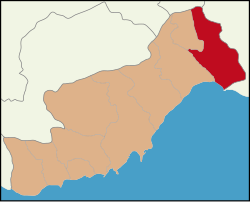 | |
| Country | Turkey |
| Province | Mersin |
| Government | |
| • Mayor | Haluk Bozdoğan (CHP) |
| • Kaymakam | Yüksel Ünal |
| Population (2020)[1] | |
| • District | 346,715 |
| Post code | 333xx |
| Area code(s) | 0324 |
| Licence plate | 33 |
| Website | www.tarsus.bel.tr |
Tarsus /ˈtɑːrsəs/ (Hittite: Tarsa; Greek: Ταρσός Tarsós; Armenian: Տարսոն Tarson; Arabic: طَرَسُوس Ṭarsūs) is a historic city in south-central Turkey, 20 km (12 miles) inland from the Mediterranean. It is part of the Adana-Mersin metropolitan area, the fourth-largest metropolitan area in Turkey with a population of 3 million people. Tarsus forms an administrative district in the eastern part of the Mersin Province and lies in the core of Çukurova region.
With a history going back over 6,000 years, Tarsus has long been an important stop for traders and a focal point of many civilizations. During the Roman Empire, Tarsus was the capital of the province of Cilicia. It was the scene of the first meeting between Mark Antony and Cleopatra, and the birthplace of Paul the Apostle.
Geography[]
Located on the mouth of the Berdan River (Cydnus in antiquity), which empties into the Mediterranean, Tarsus is a junction point of land and sea routes connecting the Cilician plain (today called Çukurova), central Anatolia and the Mediterranean sea. The climate is typical of the Mediterranean region, with very hot summers and chilly, damp winters.
Tarsus has a long history of commerce, and is still a commercial centre today, trading in the produce of the fertile Çukurova plain; also Tarsus is a thriving industrial centre of refining and processing that produces some for export. Industries include agricultural machinery, spare parts, textiles, fruit-processing, brick-making and ceramics.
Agriculture is an important source of income: half the land area in the district is farmland (1,050 km2 [410 sq mi]) and most of the remainder is forest and orchard. The farmland is mostly well-irrigated, fertilised and managed with up-to-date equipment.
Tarsus has also one of the most famous and important highschool of Turkey which is Tarsus American College, known as TAC as well.
Etymology[]
The ancient name is Tarsos, derived from Tarsa, the original name given to the city by the Hittites, who were among the earliest settlers of the region in the historical period. It was possibly derived from the storm god Tarḫunz.[2] Tarsus is first mentioned in the historical record in Akkadian texts of the Neo-Assyrian era as Tarsisi. During the Hellenistic era it was known as Antiochia on the Cydnus (Greek: Αντιόχεια του Κύδνου, Latin: Antiochia ad Cydnum), to distinguish it from Syrian Antioch. It was known as Juliopolis to the Romans, Darson in Western Armenian and Tarson in Eastern Armenian.
The Suda writes that according to the legend the city was founded by the Perseus after he fought the Isaurians and the Cilicians. An oracle told him to found a city in the place where after the victory, the flat (ταρσός) of his foot will touch the earth while he is dismounting from his horse.[3]
History[]
Antiquity[]
Foundation and prehistory[]
Excavation of the mound of Gözlükule reveals that the prehistoric development of Tarsus reaches back to the Neolithic Period and continues unbroken through Chalcolithic and Early Bronze Ages.
The settlement was located at the crossing of several important trade routes, linking Anatolia to Syria and beyond. Because the ruins are covered by the modern city, archaeology has barely touched the ancient city. Located at an important port in a merchant marine trade network spanning the eastern Mediterranean and beyond from the third millennium and earlier, from the earliest times the city was an important vortex of cultural interchange with traces of its influence visible from pre-Homeric Greek evidence forward. During the Hellenistic era it was a center of exchange among Neo-Platonic, Gnostic and Mystery traditions. The city may have been of Anatolian or Semitic origin; it is first mentioned as Tarsisi in Neo-Assyrian records of the campaigns of Esarhaddon, as well as several times in the records of Shalmaneser I and Sennacherib, the latter having the city rebuilt. A Greek legend connects it with the memory of the Assyrian king Sardanapalus (Ashurbanipal), still preserved in the Dunuk-Tach, called 'tomb of Sardanapalus', a monument of unknown origin.
Stephanus of Byzantium quotes Athenodorus of Tarsus as relating another legend:
Anchiale, daughter of Iapetus, founded Anchiale (a city near Tarsus): her son was Cydnus, who gave his name to the river at Tarsus: the son of Cydnus was Parthenius, from whom the city was called Parthenia: afterwards the name was changed to Tarsus.
Much of this legend of the foundation of Tarsus, however, appeared in the Roman era, and none of it is reliable. The geographer Strabo states that Tarsus was founded by people from Argos who were exploring this coast. Another legend states that Bellerophon fell off his winged horse Pegasus and landed here, hurting his foot, and thus the city was named tar-sos (the sole of the foot). Other candidates for legendary founder of the city include the hero Perseus and Triptolemus, son of the earth-goddess Demeter, doubtless because the countryside around Tarsus is excellent farmland. Later the coinage of Tarsus bore the image of Hercules, due to yet another tale in which the hero was held prisoner here by the local god Sandon. Tarsus has been suggested as a possible identification of the biblical Tarshish, where the prophet Jonah wanted to flee, but Tartessos in Spain is a more likely identification for this. (See further[4])
Early antiquity, Greece and Persia[]
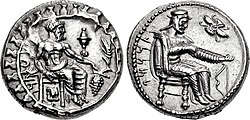
In historical times, the city was first ruled by the Hittites, followed by Assyria, and then the Persian Empire. Tarsus, as the principal town of Cilicia, was the seat of a Persian satrapy from 400 BC onward. Indeed, Xenophon records that in 401 BC, when Cyrus the Younger marched against Babylon, the city was governed by King Syennesis in the name of the Persian monarch.
At this period the patron god of the city was Sandon, of whom a large monument existed at Tarsus at least until the 3rd century AD. Coins showed Sandon standing on a winged and horned lion, and it is now thought likely that the Lion of Saint Mark on the pillar in the Piazza San Marco in Venice was in origin a winged lion-griffin from such a monument at Tarsus.[5]
Alexander the Great passed through with his armies in 333 BC and nearly met his death here after a bath in the Cydnus. By this time Tarsus was already largely influenced by Greek language and culture, and as part of the Seleucid Empire it became more and more hellenized. Strabo praises the cultural level of Tarsus in this period with its philosophers, poets and linguists. The schools of Tarsus rivaled those of Athens and Alexandria. 2 Maccabees (4:30) records its revolt in about 171 BC against Antiochus IV Epiphanes, who had renamed the town Antiochia on the Cydnus. The name did not last, however, due to the confusion of so many cities named Antioch. At this time the library of Tarsus held 200,000 books, including a huge collection of scientific works.
Roman period[]
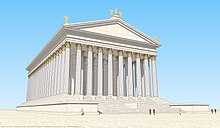
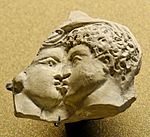

In 67 BC, Pompey, after crushing the Cilician pirates, subjected Tarsus to Rome, and it became capital of the Roman province of Cilicia.[6] To flatter Julius Caesar, for a time it took the name Juliopolis. It was also here that Cleopatra and Mark Antony met and was the scene of the celebrated feasts they gave during the construction of their fleet (41 BC). In William Shakespeare's 1606 play Antony and Cleopatra (Act 5, Scene 2), after Antony's death Cleopatra says she is going to Cydnus to meet Antony, i.e., she will commit suicide to meet him in the afterlife; "Go fetch / My best attires: I am again for Cydnus, / To meet Mark Antony"
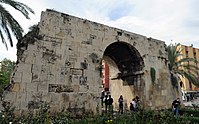
In the Roman period, the city was also an important intellectual centre, boasting its own academy. One of its leading disciples, the philosopher Athenodorus Cananites, was the tutor of the first Roman emperor, Augustus, a fact which secured continuous imperial patronage for the city.[6]
When the province of Cilicia was divided, Tarsus remained the civil and religious metropolis of Cilicia Prima, and was a grand city with palaces, marketplaces, roads and bridges, baths, fountains and waterworks, a gymnasium on the banks of the Cydnus, and a stadium. Tarsus was later eclipsed by nearby Adana, but remained important as a port and shipyard. Several Roman emperors were interred here: Marcus Claudius Tacitus, Maximinus II, and Julian the Apostate, who planned to move his capital here from Antioch if he returned from his Persian expedition.[7]
Christianity and Byzantine era[]

Tarsus was the city where, according to the Acts of the Apostles, "Saul of Tarsus"[Acts 9:11] was born, but he was "brought up" ([Acts 22:3]) in Jerusalem.[8] Paul was a Roman citizen (Acts 21:39; Acts 22: 25–29) "from Tarsus in Cilicia, a citizen of no ordinary city". Saul became Paul the Apostle after his encounter with Christ (Acts 9:11; 21:39; 22:3), and he returned here after his conversion (Acts 9:30). After about eight years, Barnabas retrieved him from Tarsus to help with the work in Syrian Antioch (Acts 11:25).
By this time a Christian community probably already existed, although the first recorded bishop, , dates only from the 3rd century. Owing to the importance of Tarsus, many martyrs were put to death there, among them Saint Pelagia of Tarsus, Saint Boniface of Tarsus, , Saint Diomedes, Saint Quiricus and Saint Julitta.
The city remained largely pagan, however, up to the time of Julian the Apostate (r. 361–363), who reportedly planned to make it his capital.[9] Following his death during his campaign against Sassanid Persia, he was buried next to the city walls, opposite the earlier tomb of the Tetrarch Maximinus Daia.[10] Emperor Justinian I (r. 527–565) undertook public works in the city, altering the course of the Cydnus river and rebuilding the bridge. Towards the end of his reign, the city suffered from riots of the Blues hippodrome faction.[10]
A cave in Tarsus is one of a number of places said to be the location of the legend of the Seven Sleepers, common to Christianity and Islam.
Bishopric[]

The first recorded bishop of Tarsus, Helenus, went several times to Antioch in connection with the dispute concerning Paul of Samosata.[11] Le Quien [12] mentions twenty-two of its bishops, of whom several are legendary.
Tarsus was the metropolitan see of the province of Cilicia Prima, under the Patriarchate of Antioch.[12] From the 6th century, the metropolitan see of Tarsus had seven suffragan bishoprics (Échos d'Orient, X, 145).
The Greek archdiocese, again mentioned in the 10th century (Échos d'Orient, X, 98), has existed down to the present day, as part of the Greek Orthodox Patriarchate of Antioch.[13]
At about the end of the 10th century, the Armenians established a diocese of their rite; Saint Nerses of Lambron was its most distinguished representative in the 12th century.
Tarsus is included in the Catholic Church's list of titular sees as a metropolitan see of both the Latin, the Maronite and the Melkite Catholic Church.[14]
Residential bishops[]
- Lupus, present at the Council of Ancyra in 314;
- Theodorus, at the Council of Nicaea in 325;
- Helladius, condemned at Ephesus, and who appealed to the pope in 433;
- the exegete Diodorus, teacher of Theodore of Mopsuestia and consequently one of the fathers of Nestorianism.[15]
- Nicholas of Tarsus, who was exiled about 525.[16]
- Kaynon, bishop of Tarsus fl 560. heretical follower of Athanasius, grandson of Empress Theodora[17]
- Abaibuus fl.847
- John fl. 979 (Jacobite bishop)[18]
- Athanasius I fl. 936 (Jacobite bishop)[18]
- Athanasius fl.1141 (Jacobite bishop)[18]
- Athanasius II fl.1264 (Jacobite bishop)[18]
Middle Ages[]
Following the Muslim conquest of the Levant in the 630s, the city came first into contact with the forces of the Rashidun Caliphate. It is unclear when the town was first captured by the Arabs, but it is clear that it, and the wider region of Cilicia, remained contested between the Byzantines and the new Caliphate for several decades, up to the early 8th century. According to the Muslim sources, during his retreat the Byzantine emperor Heraclius (r. 610–641) deliberately withdrew the population and devastated the region between Antioch and Tarsus, creating an empty no man's land between the two empires.[19]
It was not until the early Abbasid period that Tarsus, by then lying in ruins, was once more reoccupied and refortified, this time as an advanced strongpoint within the fortified zone of the al-ʿAwāṣim, stretching from Tarsus northeast to Malatya, and as an assembly centre for expeditions against the Byzantine Empire.[20] The first attempt was undertaken by al-Hasan ibn Qahtaba al-Ta'i in 778/9, but it was apparently unsuccessful, and the city was not fully restored until 787/8, by Abu Sulaym Faraj on the orders of Caliph Harun al-Rashid (r. 786–809). 3,000 Khurasanis and 2,000 Syrians (a thousand each from Antioch and al-Massisa) were given houses and land in the new fortress city.[21] Tarsus was apparently recovered by the Byzantines soon after, at some point at the turn of the century. The city probably remained in Byzantine hands during the Abbasid civil war of the Fourth Fitna, but returned to Muslim control by 830, when Caliph al-Ma'mun (r. 813–833) recommenced offensive campaigns against Byzantium, using the city as a base.[22]
Henceforth and until the Byzantine reconquest in the 10th century, Tarsus was one of the main centres for the holy war (jihād) against Byzantium, comprising annual raids (ṣawāʿif) into Byzantine lands through the Cilician Gates when the mountain snows had melted and passage was possible. These were mounted by the local garrisons, maintained by the taxation not only of the frontier zone of the al-ʿAwāṣim but also by generous subsidies from the caliphal government, and large numbers of volunteer warriors of the faith (mujahidun or ghazis).[23] Tarsus remained under direct Abbasid control until 878/9, when it and wider Cilician border zone were granted to the autonomous ruler of Egypt, Ahmad ibn Tulun. The local governor Yazaman al-Khadim returned the city to the direct allegiance to Baghdad from 882 on, but was forced to recognize the Tulunids again in 890. Tulunid possession of the border zone lasted until the death of Ibn Tulun's heir Khumarawayh in 896, after which Caliph al-Mu'tadid (r. 892–902) re-asserted direct control.[24] The area remained under Abbasid rule for the next four decades. After a brief period where the border zone was under Ikhshidid control, in 946/7, Tarsus recognized the overlordship of the Hamdanid emir Sayf al-Dawla of Aleppo, who had become the new master of northern Syria and of the Byzantine borderlands. Facing a resurgent Byzantium, he was able to stem the tide for a while, but in 965, the Byzantine emperor Nikephoros II Phokas (r. 963–969) captured the city, ending Muslim rule there.[25] Throughout this period, the governors of Tarsus also operated an active mint in the city.[26][27]
The terms of surrender of the city allowed any Muslim who wished to leave with as many of his possessions as he could carry. Many of those who left eventually settled, according to al-Muqaddasi, at Baniyas. Most of those who remained behind became Christians, and the local main mosque was either torn down or turned into a stable.[20] The city remained under Byzantine rule until 1085.[10] It was thereafter disputed between Latin Crusaders, Byzantines (1137–1172), Seljuk Turks, and the Armenians of the Armenian Kingdom of Cilicia (Kingdom of Lesser Armenia).[10] The city was the capital of the Armenian Principality of Cilicia for 118 years, between 1080 and 1198.These last became definitively masters until about 1359, when it was captured by the Ramadanids with Mamluks. Finally, the area was brought under the control of the Ottoman Empire by Selim I in 1516.
In the Middle Ages Tarsus was renowned throughout the Middle East; a number of Arab writers praised it as a beautiful and well-defended city, its walls being in two layers with five gates and earthworks outside, surrounded by rich farmland, watered by the river and the lake. By 1671 the traveller Evliya Çelebi records "a city on the plain, an hour from the sea, surrounded by strong walls two-storeys high, moated on all sides, with three distinct neighbourhoods inside the walls".
Ottoman and modern period[]

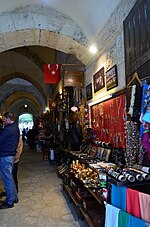
Under Ottoman rule, it initially formed part of the Eyalet of Aleppo. After the Ottoman conquest of Cyprus in 1571 it became seat of a sanjak (sub-province) within the Cyprus Eyalet, before being transferred in 1608 to the sanjak of Adana as a kaza (district).[20]
Despite its excellent defences, Tarsus was captured from the Ottomans in 1832 by the Mamluks of Ibrahim Pasha of Egypt, son of Muhammad Ali, and for 8 years remained in the hands of the Egyptians, who began growing cotton on the surrounding plain. Upon the return of the Ottomans this cotton drove a substantial growth in the economy of the area, due to increased world demand for the crop during shortages caused by the U.S. Civil War. A new road was built to the port in Mersin and the city of Tarsus grew and thrived. Still today many large houses in the city stand as reminders of the wealth generated during this period. However, after being a port for 3,000 years, by the end of the 19th century neglect resulted in Tarsus no longer having access to the sea, and the delta became a swamp. At this point Tarsus was a typical Ottoman city with communities of Muslim Turks, Christian Greeks and Armenians. At the founding of the Turkish Republic in the 1920s the swamp was drained and the River Berdan was dammed to build Turkey's first hydro-electric power station. Irrigation, roadworks and a railway brought the economy of Tarsus back to life, with new factories, particularly producing textiles.
Cuisine[]
The local cuisine includes: chargrilled chicken; hummus; şalgam (pickled turnips); tantuni (a sandwich of grilled meats); the tiny pizzas (lahmacun) called "fındık lahmacun"; and cezerye (a confection made out of carrots).
Economy[]
As of 1920, Tarsus was producing cotton, and had two cotton spinning mills with over 26,000 spindles.[28]
Sports[]
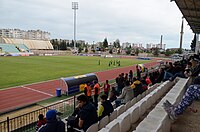
Tarsus has two football stadiums, Tarsus City Stadium and Burhanettin Kocamaz Stadium, and an arena, Tarsus Arena. Local football club is Tarsus Idman Yurdu.
Main sights[]
Tarsus is home to numerous ancient sites, with many in need of restoration and research. These have been well described by travellers over many years. For instance Blackwood's Magazine (Edinburgh) in 1890, [29] and H. V. Morton's In the Steps of St Paul in 1936. [30]
The best known include:
- Cleopatra's Gate – to the west of the city, the only ancient city gate still standing, where Antony and Cleopatra entered the city in 41 BC, though the "restoration" of this structure has involved covering much of it over with shiny new stone (see [1] for a picture of the gate before the work was done).
- The Roman bridge of Justinian over the Berdan River. It remains in good condition.
- Tarsus Museum, containing many ancient coins and a severed mummified arm.
- Roman road north of Tarsus
- Ancient road another Roman road within Tarsus.
- Kızlar Kalesi, a medieval castle ruin.
Sites of religious interest and pilgrimage include:
- The St. Paul's Church and well (it is now a museum, but occasionally Christian services can be performed there).
- The mosque said to be the burial place of the Prophet Daniel.
- The ancient story of Pegasus, the winged horse, also concerns Tarsus. Because of Pegasus' faithful service to Zeus, Pegasus was honored with a constellation. On the last day of his life, Zeus transformed him into a constellation, then a single feather fell to the earth near the city of Tarsus.
From the Turkish era are:
- Tarsus Grand Mosque, Kırkkaşık Bedesten and Bilal Habeşi Masjid
- The old baths; the dark brown spots on the white marble walls are said to be the bloodstains of , the legendary Snake King who was killed in an ambush in the baths. (see Shahmeran Hamam)
- "Nusret (Nusrat)" the minelayer used to defend the straits before the Battle of Gallipoli is being restored in Tarsus; it is to be part of a memorial park to those lost in the fighting.
Places of natural beauty include:
- Tarsus Waterfall; since the construction of the Berdan dam the water of the Tarsus river has been distributed in canals for irrigation, with the result that the waterfall can now be seen only in seasons of very heavy rainfall.
- Karabucak Forest, a popular picnic area a few kilometers south of the city center
Notable residents[]
- Mark Antony
- Cicero, Roman proconsul of Cilicia (51-50 BC)
- Cleopatra
- Paul the Apostle (Saul of Tarsus), Christian apostle, missionary, martyr, and saint, was born here and returned for a brief period later in life.
- Antipater, Stoic philosopher
- Archedemus of Tarsus, Stoic philosopher
- Caliph Al-Ma'mun died near Tarsus
- Former CEO of the Coca-Cola Company, Muhtar Kent, attended Tarsus American College
- Journalist Oral Çalışlar was born in Tarsus.
- Chrysippus, Stoic philosopher
- Hagnon of Tarsus, rhetor and philosopher
- Hermogenes of Tarsus, rhetor
- Zeno of Tarsus, philosopher
- Lokman the Physician
- Saints Cyricus and Julitta
- Saint Nerses of Lambron, Archbishop of Tarsus in the Armenian Kingdom of Cilicia
- Saint Theodore of Tarsus, Archbishop of Canterbury.
- Tarsus is one of a number of cities that claims to be the burial place of Bilal ibn Rabah, first muezzin, or caller to prayer, in Islam.
International relations[]
Tarsus is twinned with:
Gallery[]

Casemate of İbrahim Pasha

Roman Road

Berdan waterfall
Tarsus American College, Stickler Building
Statue of Shahmaran (mythology)
Ruins of Makam-ı Danyal Mosque
Old Mosque converted from church
Kırkkaşık Bazaar

The cave of seven sleepers

Toshkuyu cave
See also[]
- Tarsus (West Syriac Diocese)
- İncirgediği
- İncirlikuyu
- Kaleburcu
- Karboğazı
References[]
- ^ "Population of province/district centers and towns/villages by districts - 2012". Address Based Population Registration System (ABPRS) Database. Turkish Statistical Institute. Retrieved 2013-02-27.
- ^ Sirkeli Archaeological Project Archived 2009-01-05 at the Wayback Machine
- ^ Suda, mu, 406
- ^ Jonah 1:3 and the entry for Jonah in the Jewish Encyclopedia
- ^ See The Lion of Venice: edited by Bianca Maria Scarfi (Venice. 1990) pp.101 & 110
- ^ Jump up to: a b Bosworth, C. E. (1992). "The City of Tarsus and the Arab-Byzantine Frontiers in Early and Middle ʿAbbāsid Times". Oriens. 33: 269. doi:10.1163/1877837292X00105. ISSN 0078-6527. JSTOR 1580607.
- ^ Roger Collins, Early Medieval Europe 300-1000 (Basingstoke, Hampshire: Palgrave Macmillan, 1999) p. 40.,
- ^ "I am verily a man which am a Jew, born in Tarsus, a city in Cilicia, yet brought up in this city at the feet of Gamaliel, and taught according to the perfect manner of the law of the fathers, and was zealous toward God, as ye all are this day." --Acts 22:3
- ^ Edwards, Robert W., "Tarsus" (2016). The Eerdmans Encyclopedia of Early Christian Art and Archaeology, ed., Paul Corby Finney. Grand Rapids, Michigan: William B. Eerdmans Publishing. pp. 569–570. ISBN 978-0-8028-9017-7.
- ^ Jump up to: a b c d Foss, Clive (1991). "Tarsos". In Kazhdan, Alexander (ed.). The Oxford Dictionary of Byzantium. New York and Oxford: Oxford University Press. p. 2013. ISBN 978-0-19-504652-6.
- ^ Eusebius, Ecclesiastical History, VI, xlvi; VII, v.
- ^ Jump up to: a b Le Quien, Michel (1740). "Ecclesia Tarsensis". Oriens Christianus, in quatuor Patriarchatus digestus: quo exhibentur ecclesiæ, patriarchæ, cæterique præsules totius Orientis. Tomus secundus, in quo Illyricum Orientale ad Patriarchatum Constantinopolitanum pertinens, Patriarchatus Alexandrinus & Antiochenus, magnæque Chaldæorum & Jacobitarum Diœceses exponuntur (in Latin). Paris: Ex Typographia Regia. cols. 869–876. OCLC 955922747.
- ^
 Herbermann, Charles, ed. (1913). "Tarsus". Catholic Encyclopedia. New York: Robert Appleton Company.
Herbermann, Charles, ed. (1913). "Tarsus". Catholic Encyclopedia. New York: Robert Appleton Company.
- ^ Annuario Pontificio 2013 (Libreria Editrice Vaticana, 2013, ISBN 978-88-209-9070-1), p. 984
- ^ Eusebius, Historia Ecclesiastica, VI, xlvi; VII, v). Le Quien (Oriens christianus, II, 869-76)
- ^ Michael the Syrian :89.
- ^ Michael the Syrian :102.
- ^ Jump up to: a b c d Le Quien, Michel (1740). "Ecclesia Tarsi". Oriens Christianus, in quatuor Patriarchatus digestus: quo exhibentur ecclesiæ, patriarchæ, cæterique præsules totius Orientis. Tomus secundus, in quo Illyricum Orientale ad Patriarchatum Constantinopolitanum pertinens, Patriarchatus Alexandrinus & Antiochenus, magnæque Chaldæorum & Jacobitarum Diœceses exponuntur (in Latin). Paris: Ex Typographia Regia. cols. 1465–1468. OCLC 955922747.
- ^ Bosworth, C. E. (1992). "The City of Tarsus and the Arab-Byzantine Frontiers in Early and Middle ʿAbbāsid Times". Oriens. 33: 269–270. doi:10.1163/1877837292X00105. ISSN 0078-6527. JSTOR 1580607.
- ^ Jump up to: a b c Bosworth, C. E. (2000). "Ṭarsūs". In Bearman, P. J.; Bianquis, Th.; Bosworth, C. E.; van Donzel, E. & Heinrichs, W. P. (eds.). The Encyclopaedia of Islam, New Edition, Volume X: T–U. Leiden: E. J. Brill. pp. 306–307. ISBN 978-90-04-11211-7.
- ^ Bosworth, C. E. (1992). "The City of Tarsus and the Arab-Byzantine Frontiers in Early and Middle ʿAbbāsid Times". Oriens. 33: 271–273. doi:10.1163/1877837292X00105. ISSN 0078-6527. JSTOR 1580607.
- ^ Bosworth, C. E. (1992). "The City of Tarsus and the Arab-Byzantine Frontiers in Early and Middle ʿAbbāsid Times". Oriens. 33: 273–274. doi:10.1163/1877837292X00105. ISSN 0078-6527. JSTOR 1580607.
- ^ Bosworth, C. E. (1992). "The City of Tarsus and the Arab-Byzantine Frontiers in Early and Middle ʿAbbāsid Times". Oriens. 33: 270–271. doi:10.1163/1877837292X00105. ISSN 0078-6527. JSTOR 1580607.
- ^ Bosworth, C. E. (1992). "The City of Tarsus and the Arab-Byzantine Frontiers in Early and Middle ʿAbbāsid Times". Oriens. 33: 274–276. doi:10.1163/1877837292X00105. ISSN 0078-6527. JSTOR 1580607.
- ^ Bosworth, C. E. (1992). "The City of Tarsus and the Arab-Byzantine Frontiers in Early and Middle ʿAbbāsid Times". Oriens. 33: 276–278. doi:10.1163/1877837292X00105. ISSN 0078-6527. JSTOR 1580607.
- ^ Miles, George C. (1957). "Islamic coins from the Tarsus excavations of 1935-1937". The Aegean and the Near East, Studies presented to Hetty Goldman. New York. pp. 297–312.
- ^ Stern, S. M. (1960). "The Coins of Thamal and of Other Governors of Tarsus". Journal of the American Oriental Society. 80 (3): 217–225. doi:10.2307/596170. JSTOR 596170.
- ^ Prothero, G.W. (1920). Anatolia. London: H.M. Stationery Office. p. 113.
- ^ Bent J T. Tarsus – Past and Present. Blackwood's Magazine (Edinburgh) Volume 148, 1890 pp 616-625
- ^ H. V. Morton. In the Steps of St Paul, London: Rich & Cowan, 1936
External links[]
| Wikimedia Commons has media related to Tarsus. |
- Tarsus, Mersin
- Archaeological sites in Mersin Province, Turkey
- Ancient Greek archaeological sites in Turkey
- Seleucid colonies in Anatolia
- Hittite cities
- Cilicia (Roman province)
- New Testament cities
- Populated places in ancient Cilicia
- Populated places in Mersin Province
- Catholic titular sees in Asia










